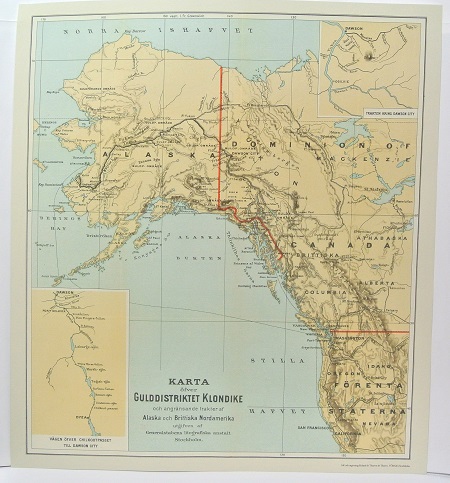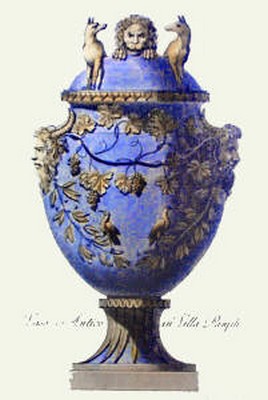HOMANN, JOHANN BAPTIST.
Biografiska uppgifter:(1663-1724. Född i Kamlach, död i Nürnberg.
Tysk kartograf. Han fick sin första undervisning hos jesuiterna i sin hemstad och skulle ha blivit munk men gick istället över till den evangeliska kyrkan. Bosatte sig i Nürnberg där han 1687 blev notarie. Som hobby började han på lediga stunder att kopiera kartor. Det visade sig snart att han hade betydande talang som kartritare, och 1702 grundlade han sitt eget kartförlag. Han fick snart rykte som den mest betydande av tyska kartografer, och hans kartor nådde en stor publik. Totalt ritade han 200 olika landkartor, något färre jordglober, astronomiska instrument och andra mekaniska arbeten. Hans stora världsatlas, 'Grosser Atlas ueber die ganze Welt', kom 1716 i 126 blad, och 'Atlas methodicus' år 1719 i 18 blad. Hans son, Johann Christoph Homann, fortsatte verksamheten efter faderns död.
Johann Baptist Homann (20 March 1664 – 1 July 1724) was a German geographer and cartographer, who made maps of the Americas.
Life
Homann was born in Oberkammlach near Kammlach in the Electorate of Bavaria. Although educated at a Jesuit school and preparing an ecclesiastical career, he eventually converted to Protestantism and from 1687 worked as a civil law notary in Nuremberg. He soon turned to engraving and cartography; in 1702 he founded his own publishing house.
Homann acquired renown as a leading German cartographer, and in 1715 was appointed Imperial Geographer by Emperor Charles VI. Giving such privileges to individuals was an added right that the Holy Roman Emperorenjoyed. In the same year he was also named a member of the Prussian Academy of Sciences in Berlin. Of particular significance to cartography were the imperial printing privileges (Latin: privilegia impressoria). These protected for a time the authors in all scientific fields such as printers, copper engravers, map makers and publishers. They were also very important as recommendation for potential customers.
In 1716 Homann published his masterpiece Grosser Atlas ueber die ganze Welt (Grand Atlas of all the World). Numerous maps were drawn up in cooperation with the engraver Christoph Weigel the Elder, who also published Siebmachers Wappenbuch.
Homann died in Nuremberg. He was succeeded by the Homann heirs company, in business until 1848, known as 'Homann Erben', 'Homanniani Heredes', 'Heritiers de Homann' abroad.
Atlas Methodicus
Eighteen 28 x 24 cm copperplate engravings, 31 x 25 cm sheet sizes, original hand colour, + frontispiece, Nürnberg, 1719 We are pleased to offer this scarce and important original set of the complete maps of the Atlas Methodicus published by the Imperial Geographer Johann Baptist Homann (1663-1724) and founder of the leading German map publishing firm of the 18th century . This charming atlas was designed for geographic instruction by the Hamburg-based scholar and educator Johann Hübner (1668-1731), who had devised a system of presenting maps marked only with letters showing the first initial of a placename which could then be cross referenced to an alphabetical list. Hübner taught at both the Gymnasium and University level, and the remarkable number of encoded placenames present on the maps shows that he expected a high level of geographic literacy indeed. We begin our survey of the maps with the Americas map, which provides a fascinating snapshot of European knowledge of New World geography in the first decade of the 18th century. Right away we notice the large Island of California as well as an enormous amorphous landmass in the Pacific Northwest - note also Greenland's connection to the North American continent:
Taking a closer look at North America from this map reveals Hübner's method of teaching. We see the letter 'C' for the insular California, 'S.L. fl.' for Saint Lawrence River, 'NA' presumably for Nova Albion, 'P' for Pennsylvania, 'V' for Virginia, 'F' for Florida, 'L' for Louisiana, 'M' for Nova Mexico and so on. Note the separation between Lakes Erie and Ontario and river connection from Lake Superior through an odd network of lakes all the way to Hudson Bay. East of the Island of California an inlet hints at a possible large inland sea that was postulated on maps of the time, but Homann and Hübner decided to leave the unknown northwest blank. Note also in the general region of what is now Georgia and the Carolinas a large inland lake, a misconception that originated with Jodocus Hondius who in creating his famous map 'Virginiae Item et Floridae' combined data from a 16th century map by French explorer, artist and cartographer Jacques Le Moyne des Morgues with a 1590 map of Virginia by John White of Roanoke Colony fame. Hondius inadvertently compressed the Carolina coast to a significant extent and for some reason elected to show Le Moyne's River May terminating in a large fresh water lake. The lake appeared on nearly all subsequent maps of the region well into the 18th century, bolstered by the bizarre account of one John Lederer of Virginia who published an account of his supposed visit to the lake which he called 'Ushery':
'The water of Ushery-lake seemed to my taste a little brackish, which I rather impute to some Mineral-waters which flow into it, then to any saltness it can take from the Sea, which we may reasonably suppose is a great way from it. ...How far this Lake tends Westerly, or w it ends, I could neither learn or guess.'
Next we turn to the Europe map which presents a portrait of the political borders circa 1719. Note that Hübner conducted his instruction in Latin, hence 'PE' for Pontus Euxinus for Black Sea, etc... :
The Asia map shows an enormous Hokkaido ('Y' for 'Yesso' as it was known at the time, variant Jesso) adjacent to an enormous (and of course non-existent) eastern island, and no Kamchatka or Sakhalin:
Africa follows the conventions of maps of the period with the source of the Nile is located in two enormous inland lakes north of the fabled Mountains of the Moon:
The twin hemisp world map with two polar charts compresses all cartographic curiosities of the continent maps into one convenient mappe-monde:
The original frontispiece is a true masterpiece of the engraver's art most likely from the burin of Homann himself. An Athena figure looks on as a geography less...
Bland arbeten:
Grosser Atlas ueber die ganze Welt.
Atlas methodicus.
Tillbaka till början.



